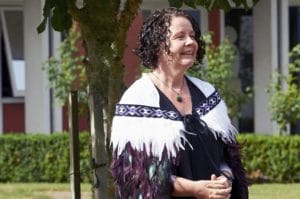As I write this piece, we have just completed Term 1, still Covid-minded, and hopeful that the world will return to normal. Indeed, the question we have contemplated, for almost a year now, is what is normal, and do we really want to return to that? Or do we capture the

Catherine Gunn
opportunity to be like Mary, and lay out our version of a just and equitable society, and grow our young women to be the generation which will challenge and shape our world into a place of justice and peace? This past year has changed us all in numerous ways, and the changes, especially in education, are not slowing down. Consequently, we are forced to rethink and reimagine, in fundamental ways, the experience of school for students and teachers, and for a Mission School, what does it mean to be like Mary and bring Christ into this world?
Our vision and mission expressed is: Ignite the passion; inspiring young women to change the world — me aro ki te hā o Hineahuone. Such a lofty and aspirational statement raises the question…what kind of woman does this? What kind of woman is this? The proverb, “She is clothed with strength and dignity, and she laughs without fear of the future. When she speaks, her words are wise, and she gives instructions with kindness” provides an image of the kind of young women we shape and form at Sacred Heart Girls’ College to be world changers. Although we usually look to our own mothers as the primary example of “inspired” women, it is the image and example of Mary that captures the essence of a strong, dignified woman of faith, hope and justice.
Mary, whom we meet as a young girl, full of potential, who said “yes” to changing the world, and whom we accompany through her mission, continuing to say “yes”, who greets her kinswoman, Elizabeth, at the Visitation, where we learn of her vision for a transformed world, through the words of the Magnificat: a world of justice, peace and reconciliation. We are fortunate to live in a part of the world where we can exercise choice, claim our right to education, participate in society, earn an income, and live a life that’s free from violence, discrimination and unrest; and we also know this is not the case for all, and the education and formation of women can, in particular, as we have seen through Euphrasie Barbier and her Mission Sisters today, initiate and sustain social change and justice, and indeed change the world.
Therefore, at Sacred Heart Girls’ College, our philosophy is to encourage our young women to influence the world as women of faith, hope and justice: we want them to engage with the big ideas that shape our world; we want them to develop the attitudes and attributes they will need to navigate these big ideas; and we want them to be sufficiently skilled and competent to serve and be in a world that is unpredictable and ever-changing, as a consequence of these big ideas: so who is this 21st century version of Mary?
I am from women less quiet,
women of the shout and the stomp,
testifying wherever they could
make their voices heard.
I am from Miriam and Mary
and Magdalena and from women
unknown and unnamed,
women who carried their prayers
not in books
but in their blood
and in their bones,
women who passed down the
sacred stories
from body to body.
I am from them,
listening for their voices,
aching to hear,
to tell, to cry out,
to make a way for those
yet to come.
(Jan Richardson, adapted from “In the Sanctuary of Women”)
Defying the stereotype of a meek, mild-mannered woman, we encounter Mary throughout the Gospel as a courageous, passionate, visionary woman, who, ultimately, stood at the cross, as she grieved the death of her son: still faithful, courageous and dignified; still hopeful for a better world, and still saying “yes” to justice, as she led the early disciples through difficult and transformative times for the early Church. God often chooses unconventional people for an important task, and the call of Mary was no less radical than the call of Elizabeth, Miriam, Hannah and Judith, all of whom also sang songs of salvation, and victory songs of the oppressed.
For our college, this significant piece of Scripture helps us to focus on what matters most: a culture of learning that emphasises the holistic formation of our learners: balanced, healthy and abundant with opportunities for growth in faith, hope and justice. Indeed, like Mary, we want our wāhine to sing a song of justice and turn their world upside down.
The Magnificat also serves as a pertinent reminder that our mission takes us to places where we may not want to go: to feed the hungry, clothe the naked, welcome the stranger, visit the sick and imprisoned . . . literally and metaphorically, we do this every day for our community: for the students in our learning spaces, for their whānau in their homes, and for the wider community who make the streets their home.
Bringing Christ to the world, like Mary, is hard work, because it’s heart-work: Sacred Heart work! Despite that, “my soul magnifies the Lord, and my spirit rejoices . . . and the Spirit imbues us every day, with abundant grace, to follow our own calling, as our companion in hope reminds us, “have confidence in God, be humble, love prayer and be very kind” (Euphrasie Barbier, 1789).
Catherine Gunn is principal of Sacred Heart Girls’ College, Hamilton.

Reader Interactions